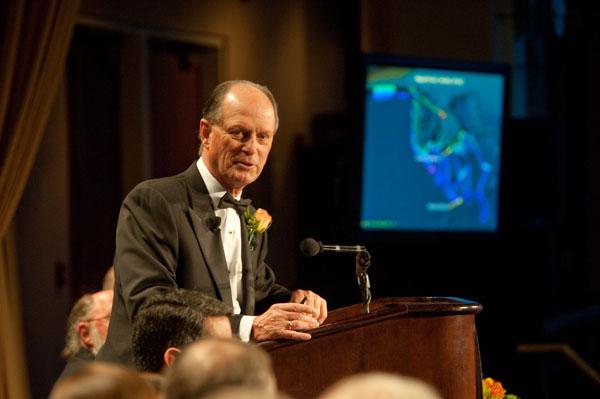
Titanic Discoverer Charts New Sea Adventures

Call him Captain Nemo he won't mind a bit.
Robert Ballard, the famous U.S. oceanographer, takes after that fictional character portrayed in the Jules Verne novel, "Twenty Thousand Leagues Under the Sea."
Ballard is perhaps largely known for his historic 1985 discovery of the RMS Titanic, the long-lost passenger liner that tragically slipped deep beneath the North Atlantic after hitting an iceberg. But this undersea adventurer has also carried out more than 100 deep-sea expeditions using the latest in aqua-technology.
And the best is yet to come: from searching for bizarre extremophiles to looking for ancient ships along with their crew members preserved in a mummified state.
Ballard was the keynote speaker on dry land last month, talking before the National Space Club-sponsored 54th Annual Robert H. Goddard Memorial Dinner, a prestigious black-tie affair of 2,300 attendees, including astronauts, NASA and aerospace industry leaders.
Tremendous resources
"It's sort of ironic that you can walk on the moon ... but no one has ever walked on the deep sea . Because if you did, you'd sink rather quickly, plus the pressure would probably ruin your day," Ballard said. In contrast to moonwalking astronauts able to get out of their capsule and strut around, "I'm actually encapsulated inside my submarine," he said.
Sign up for the Live Science daily newsletter now
Get the world’s most fascinating discoveries delivered straight to your inbox.
While an admitted admirer of space exploration, along with space travelers that can gawk at our planet from on high, Ballard said: "If you really want to get to know the Earth, you need to go beneath the sea." Indeed, half of the United States' territory lies under ocean water.
Underwater discoveries are ahead, Ballard noted, including "tremendous resources" of oil, gas and minerals, as well as fisheries all of which are important to world economies.
Around 100,000 sea mounds likely await detection, Ballard predicted, all of which are characterized by deposits of rare metals.
"A lot of these wonderful places will be set aside as national marine sanctuaries ... beautiful areas where creatures are protected," Ballard added, safe havens to look after and promote, and places to preserve underwater treasures.
Repository of human culture
Diving further into his talk, the oceanographer called the deep sea "a great repository of human culture." That is, there's more history in the deep sea than all of the world's museums combined, he noted, underscoring an estimate that there are more than 1 million ships of antiquity sitting underwater , undiscovered.
Ballard has recently been working in the Black Sea. Due to anoxic (free of oxygen) conditions there, ships are found to be entirely preserved (oxygen can contribute to the processes that break down wood and other materials). One ship discovered a few years ago, he said, went down 1,500 years ago and is still preserved.
The Black Sea is ideal for underwater archaeological research given the history of maritime cultures in that area, Ballard said.
"As we continue to excavate these sites, we actually expect to find the crew members perfectly mummified ... with all their DNA," Ballard said.
Today, there is an upsurge in ocean exploration. A few years ago, the National Oceanic and Atmospheric Administration's (NOAA) Office of Ocean Exploration and Research was established. Moreover, America now has two dedicated ships of exploration, Ballard said: The NOAA Ship Okeanos Explorer and Ocean Exploration Trust's Exploration Vessel Nautilus.
Ballard is president of Ocean Exploration Trust, an organization dedicated to guiding the future of ocean exploration . The mission of these two ships, he continued, "is to go where no one has gone before on planet Earth."
Out-of-body experience
Telepresence-enabled exploration is on tap for these ocean-going vessels, each equipped with sonar equipment and remotely operated vehicles outfitted with high-definition video cameras and sensors. These ships transmit information to a shore-based mission control.
At the University of Rhode Island, the newly opened Inner Space Center a brainchild of Ballard's is connected to Internet2, which permits high bandwidth streams of video, audio and data to flow into the facility where it is captured, displayed and disseminated in real time to broadly distributed teams of explorers.
Additionally, a sizable education network that includes the Boys and Girl Scouts of America, libraries, museums, aquariums and science centers are hooked in to real-time ocean journeying. Those taking part in the network are guaranteed front-row seats to exploration.
"There's a fascinating thing about ships of exploration. You don't know what you're going to discover," Ballard said. The two ships, the technology and all involved enable the delivery of the smartest minds, no matter when, no matter where, within 30 minutes of a discovery.
"We believe that the classrooms of tomorrow will be an amazing opportunity to have out-of-body experiences," Ballard said. "The generation of kids right now in school are living in the ether ... living in the Matrix. We believe we have an excellent opportunity to involve them in our work."
To check in on Robert Ballard's oceanic exploits, go to: http://nautiluslive.com/

Leonard David is an award-winning space journalist who has been reporting on space activities for more than 50 years.









